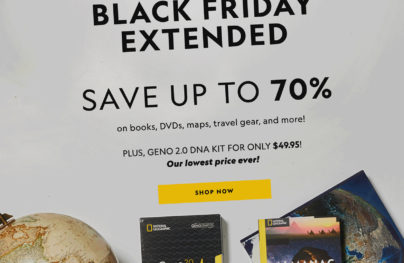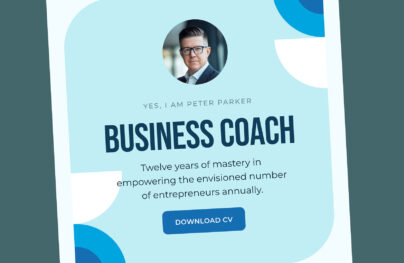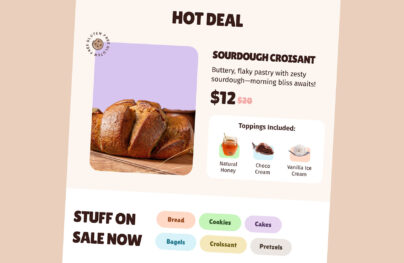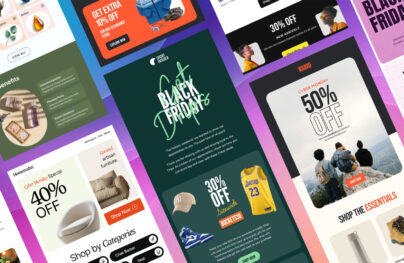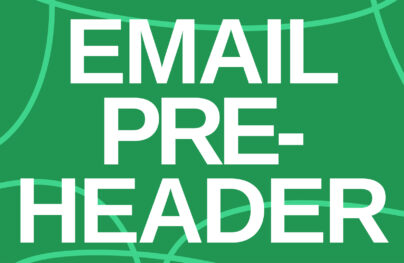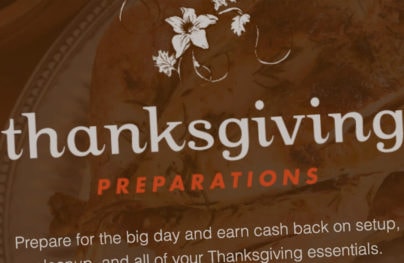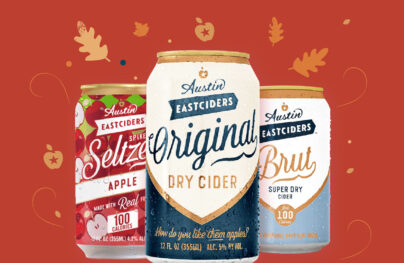B2B Email Marketing Guide: Best Strategies, Ideas and Examples
The business-to-business sector might differ from business-to-consumer, but one thing is certain: both benefit from email marketing. Forbes says that over 80% of B2B marketers use digital correspondence to connect with their audience, deliver targeted messages, nurture leads, and drive conversions. Most marketers agree that this method of communication outperforms phone calls, events, and ads due to its high engagement and response rates.
On the other hand, studies showed that 3 out of 4 B2B buyers believe email is the top choice for communication as it delivers clear, concise, and timely information and provides them with the necessary material to make a decision. Therefore, last year, almost 90% of marketers maintained their budget for this communication, with some intending to increase it.
B2B email marketing is crucial to a company’s successful presence in the market. It is an ideal channel for professional interactions that meet buyers’ expectations and provides companies with a reliable and multifunctional tool to reach the right audience directly with the brand message. Let’s uncover its potential, challenges, and key strategies.
What Is B2B Email Marketing?
Business-to-business email marketing refers to a type of digital marketing that uses an email channel for communication between companies. The client company is represented by a person or a team that works on behalf of the organization and aims to address the needs, demands, and challenges of the company or its customers.
B2B email marketing is integral to digital marketing in companies across niches, starting with a local furniture manufacturer and ending with a digital goliath like Amazon. It is based on different types of email campaigns to accomplish these tasks:
- Inform about the company, its products, and trends in the niche
- Promote new features and offers
- Establish and maintain strong professional relationships between the company and the company
- Cement company’s position in the market
- Increase brand awareness
- Reinforce brand identity
- Drum up interest and generate leads
The ultimate goal is to drive sales within the business community and generate revenue necessary to forward business.
With Postcards Email Builder you can create and edit email templates online without any coding skills! Includes more than 100 components to help you create custom emails templates faster than ever before.
Free Email BuilderFree Email TemplatesDifferences between B2B and B2C Email Marketing
B2B email marketing intends to tackle the same tasks and achieve similar goals as B2C email marketing – directly delivering relevant information to address the company’s pain points and increase productivity. However, it does that differently. Consider the main distinctions between these two business sectors. The B2B email marketing does the following:
- It targets companies, entrepreneurs, and professionals.
- It seeks a niche for better audience targeting rather than funneling consumers.
- It intends to build professional relationships with companies rather than personal ones.
- It focuses on long-term partnerships and multi-factor decision-making processes.
- It prioritizes branding and its positioning on the market.
- It strives to maintain open communication and focuses on logical process-driven purchasing decisions as it handles long sales cycles.
- It centers its campaign around logic and features rather than desires and benefits.
- It relies on detailed, technical copy enriched with terms to address specific business needs.
- It might have lower volume and higher prices, unlike higher volume and low prices of B2C.
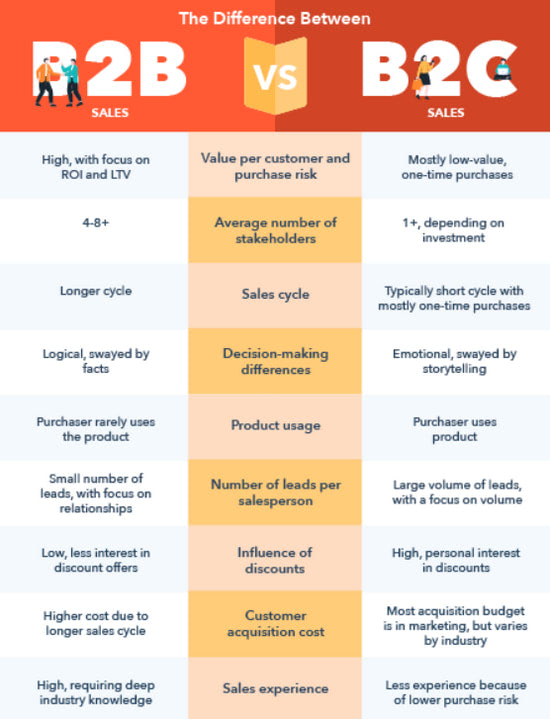
Differences between B2B and B2C sales cycle (visual snippet by Hubspot
4 Core Email Campaigns
B2B email marketing has many tools in its arsenal, but primarily, it relies on these four core email campaigns.
- Welcome emails: Usually compact and concise, yet straight to the point, they serve as the first interaction point between the company and representatives of the targeted company. They notify about the successful signing process, lay the groundwork for expectations about process and communication, and establish a strong foundation for building professional relationships.
- Onboarding Emails: These emails follow the welcome series and introduce the company and its product in all its glory. They could also be the first point of contact after purchasing. They intend to reduce friction, manage expectations, and ensure the customer gets the most out of a product and remains with the company for the long term.
- Informative Emails: Usually content-heavy, they help your audience learn more about your brand and its products. They may report on company changes, notify customers about product updates, inform them about new items in the range, and keep customers informed about new developments within the industry.
- Promotional Emails: Unlike informative emails, promotional emails are commercial broadcasts that inform about special discounts and sales and offer incentives to drive sales and revenue for a business. They might include coupons, access to exclusive content, or admittance to an invitation-only event.

Welcome email from Only Domains
Importance of B2B Email Marketing
B2B email marketing is one of the most direct ways to reach prospective customers (aka a person who represents an organization). It is hugely important for a successful company’s growth and existence in the market. Here are some good reasons.
It Is What Buyers and Stakeholders Need and Expect
While social media, rich in photos and discussions, is widely used to keep up to date with friends and family, email marketing is a professional medium for communicating and delivering technical information. According to MarketingSherpa, people want to receive promotional content through email. Organizations and their representatives across niches expect their suppliers to reach them through this channel with meaningful content.
Therefore, a thoughtfully created B2B email marketing campaign meets buyers’ expectations of receiving all necessary information about products and services in a simple, clutter-free way.
It Is Cost-Effective
Some studies showed that email marketing has a return on investment of up to 4,400%. That is huge compared to other distribution channels. With the right contact list, companies may generate quality leads and boost a stellar return on investment without making a massive dent in their budget.
With Startup App and Slides App you can build unlimited websites using the online website editor which includes ready-made designed and coded elements, templates and themes.
Try Startup App Try Slides AppOther ProductsHere are some other reasons why email marketing stands out as a budget-friendly powerhouse.
It has a low entry barrier as most professional software offers free or low-cost plans, making email marketing equally accessible to businesses at any stage in the development cycle.
It is flexible. Companies may increase or minimize their presence in the channel without any huge investments.
It is scalable. You do not need to invest much money immediately; with an ESP’s tiered pricing plans, B2B email marketing can scale seamlessly as a business grows.
It allows for better strategy optimization, which yields better results and encourages companies to make smart investments.
It Builds Strong Relationships
B2B email marketing is one of the best and simplest ways to establish and maintain strong professional relationships between company and company. As a direct channel for communication that organizations consider a professional medium, it produces the right impression and creates lasting connections that drive business success.
Although B2B email marketing is generally devoid of an emotional component, tools like segmentation and hyper-personalization naturally tug at buyers’ hearts and earn a special place in their hearts.
By crafting engaging and personalized emails, companies maintain consistency in message delivery and brand positioning, speak to their customers in the same language, gain their trust, and drive conversions by providing value.
It Underlies Better Marketing Decisions
B2B email marketing is a great way to understand what content your target audience is looking for and what pain points you need to address now. As companies analyze the performance of their campaigns, content, and offers, they get relevant insights and an overall picture of the target audience’s condition.
This information provides companies with a solid ground for making informed decisions, optimizing future email campaigns, and even introducing enhancements across other digital communication channels by altering their content strategy.
In addition, companies may use email channels to gain reliable and direct consumer feedback using simple, unobtrusive instruments like surveys, quizzes, and questionnaires.

Popular Mistakes of B2B Email Marketing
B2B email marketing might be powerful in what it can do for your business, but it has its share of obstacles to overcome. Apart from the common challenges like earning new subscribers, retaining loyal fans, boosting click-through rates, and achieving a measurable return on investment, there are some unique barriers to breaking through caused by several common mistakes.
Follow Unrealistic Timeline
One of the most significant mistakes by marketers is trying to accomplish too much too soon. They set achievable targets but falsely follow unrealistic timelines.
Unlike B2C, where the sales cycle is short and can be easily triggered by a well-played incentive, B2B email marketing takes time to accomplish its goal. It centers around building strong relationships with companies, proving their validity, and building trust.
Companies often forget that decision-making involves various stages, such as research, proposal, negotiation, and multiple approvals. The latter might take months. In addition, the much smaller pool of businesses that might need the company’s product slows progress.
Therefore, companies must set realistic timelines and deadlines. They should build long-term strategies, allocate time, avoid rush decisions, and progress slowly toward their goals.
Misunderstand the Sales Cycle
Many B2B companies falsely believe their sales cycle is similar to selling to consumers. While they might have similarities, they are not the same.
Unlike B2C, where the individual is the final decision-maker, B2B has several decision-makers to win over. This could include executives, CEOs, boards of directors, or even teams using your product. Therefore, a convincing game should spread across different levels to meet the needs and expectations of everyone involved.
B2B email marketers should also be perfectly aware of how many touchpoints prospects need before converting and how many times they should reach their contact with follow-up when creating drip campaigns.
B2B email marketers should remember companies with more complex needs do not seek fast solutions. Many businesses require customized and configured products that meet their particular needs. Therefore, some B2B email marketing campaigns should focus on high-level technical consulting.
Understanding the sales cycle is critical for any business in any sector. Knowing what other companies want and need is essential, as this will inform the types of emails the company will ultimately send.
Use Emotional Language in Content
B2B email marketing has a slightly different philosophy than B2C. As it markets to companies and professionals rather than individuals, it should focus on the product’s logic, features, and benefits rather than addressing desires. Email campaigns should look and feel professional, providing information that solves the issue, increases productivity, or assists organizations in improving collaboration with their target audience.
Nevertheless, many companies forget that and use psychological tricks to tug at their customers’ heartstrings. This tactic might work sometimes because people who make decisions are still human beings with desires and inclinations. Nevertheless, as they act on behalf of the organization, they prioritize the technical and economic side of the deal. Therefore, companies must meet these expectations and deliver content that looks and feels professional across boards.
Slowly Adapting to New B2B Buying Behavior
Finally, one of the most common mistakes B2B email marketers make is slow or poor adaptation to new buying behavior. While the B2B world is not as spontaneous and trend-dependent as B2C, companies still must meet the relevant audience’s needs, thereby undergoing corresponding changes.
What worked before might not work as efficiently as you want. B2B email marketers must be where the buyers are, providing value at every touchpoint. In addition, they need to influence near-term purchasing decisions at the bottom and top of the funnel, embracing changes at various levels.
Key Strategies for Effectively Running a B2B Email Marketing
Unlike the B2C sector, which is more transactional, B2B email marketing is more settled. It prioritizes long-term over short-term goals, employing tools to build long-standing relationships through meaningful messages and technical specifications. Here are common strategies based on core email campaigns that companies in the B2B sector employ to achieve their targets.
Welcome Emails
Welcome emails are among the top two digital newsletters B2B marketers send clients. They are popular because they are increasingly powerful in what they can do for any business in the email channel.
They stand behind the first impression. It always counts whether you sell to an individual or an organization. The more impressive, meaningful, and memorable it is, the better.
It is crucial for successful double opt-in registration to verify the client’s address and engagement and, therefore, ensure good deliverability.
It expresses gratitude and sets the right tone for new relationships, showing companies in the best light.
It ensures the client’s comfortable adaptation to your collaboration. Welcome emails may provide crucial information for the next step or even reveal tips, tutorials, and step-by-step guides, serving as a great tool to eliminate confusion and misunderstanding.
In general, welcome emails include this kind of information:
- A welcoming note from the CEO or team member
- Words of gratitude
- Links to a preference center and privacy policy
- Frequency of future emails and communication
- Unsubscribe link
- Brief overview of what the company offers
- Helpful tips on getting started
- Product or company benefits or unique features
- Information regarding your social media pages, along with clickable buttons
- Testimonials and reviews
- Special discounts for newcomers
While you might turn the welcome email strategy into a series to get your clients deeper into the company’s mission and product, it is highly advisable to use onboarding emails, as they were created specifically for this purpose.
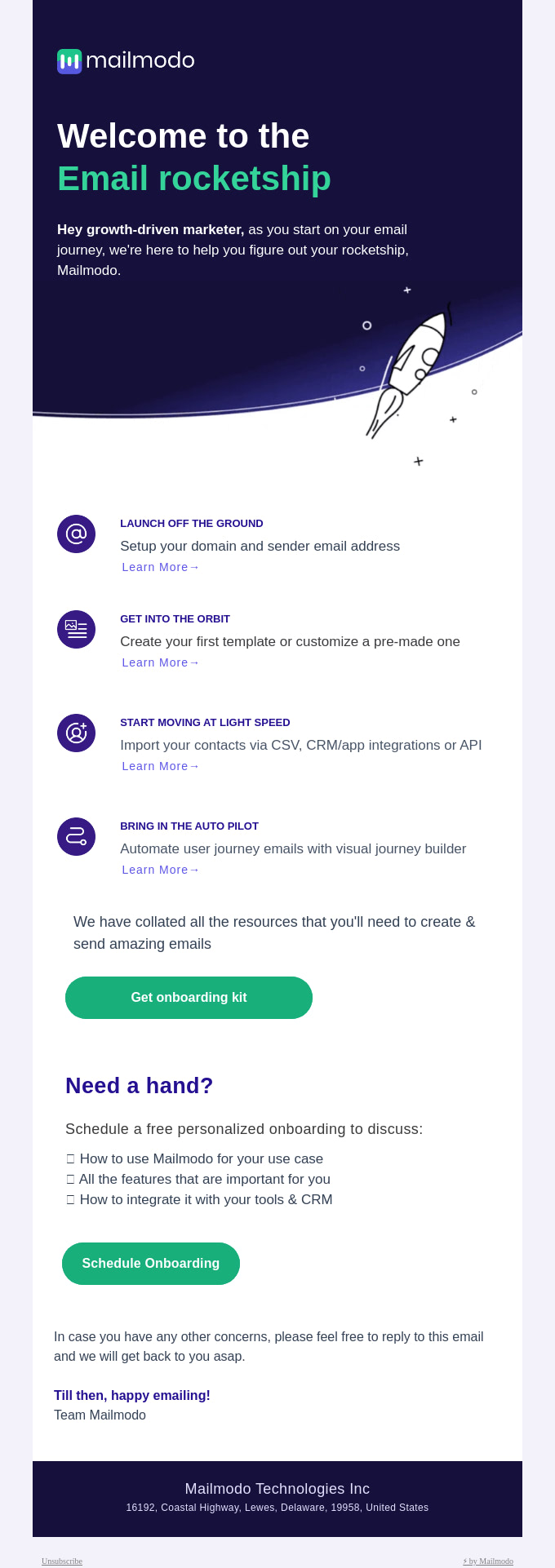
Onboarding Emails
While B2C companies may skip this type of email campaign, B2B companies strongly rely on them to be successful. Onboarding emails serve as one of the first interactions with customers and steps into the technical introduction of the company’s products. They are crucial for starting relationships with customers on the right note and providing them with all the necessary information to move forward.
Onboarding email shapes the initial customer experience and lets the company deliver its promise. As a rule, companies create onboarding messages to familiarize new customers with the interface, key features, and platform. They do it in steps to demonstrate how to get the most value possible from their collaboration and not overwhelm or scare them away with too much data.
For example, many SaaS representatives use onboarding emails to support their free trial periods, making them productive and turning leads into revenue.
Onboarding emails do these tasks:
- Help new users learn how to leverage a product
- Highlight distinctive features
- Demonstrate the unique value that only the company’s product has
- Deliver relevant communication to promote consistency
- Educate organizations
When done right, onboarding emails help companies increase product and company satisfaction, drag clients deep into the funnel, reduce churn, and generate much-needed engagement to prolong their collaboration.
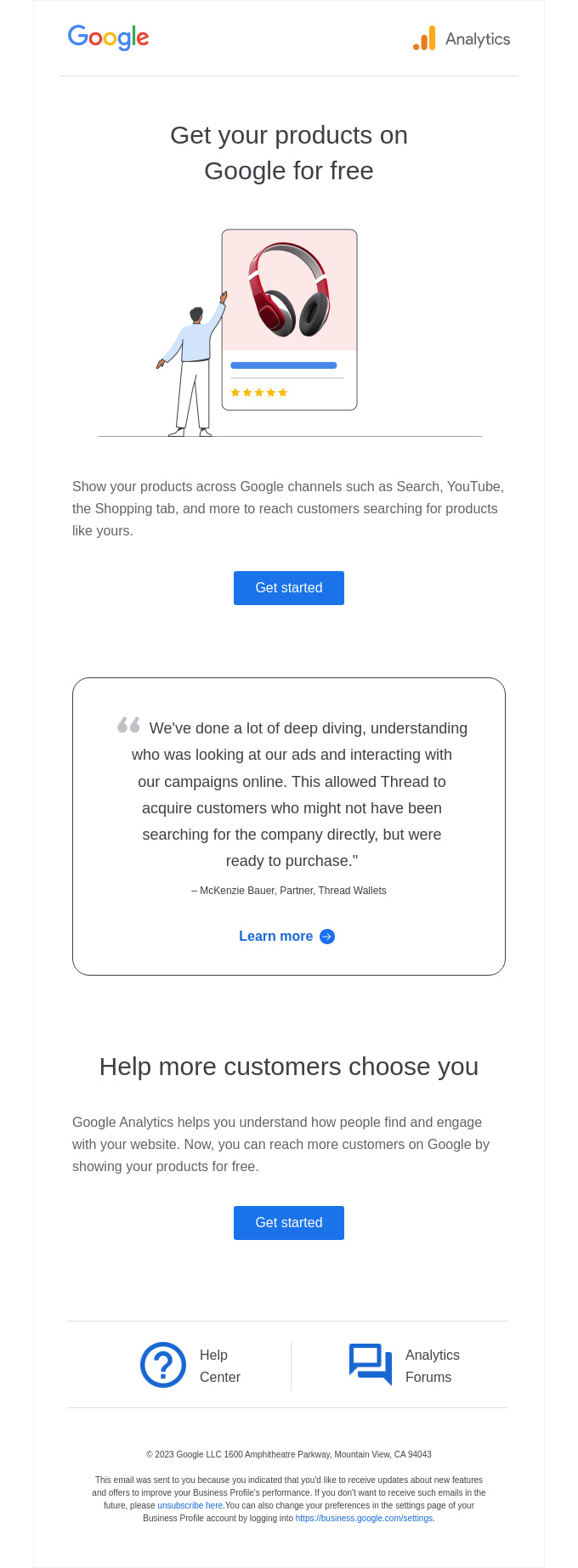
Informative Emails
Do you know that over 80% of B2B marketers believe informative emails to be the most effective type of digital correspondence? The reason for that is simple: Customers in B2B sectors need a wealth of information to justify their decisions and get approval from stakeholders: logic and technical specifications rule in business. There are no spur-of-the-moment purchases—only ones based on well-considered decisions.
Therefore, informative email campaigns perfectly fit customers’ demands. Companies employ them to provide essential information, anticipate questions, offer additional resources, and bring customers up to speed about your latest content and product announcements.
Moreover, informative emails are great tools for establishing a brand’s expertise in the niche, as they might demonstrate their skills and knowledge and prove their devotion and commitment to the industry.

Adventurera – email template from Postcards
Promotional Emails
B2B email marketing would not have happened without promotional campaigns. Promotional campaigns are time-proven lead nurturing campaigns designed to promote special offers, limited-time deals, exclusive content, or admittance to an invitation-only event.
Companies across niches get the advantage of this type of email campaign. They use them to accomplish these tasks:
- Encourage contacts to take action, such as starting a trial, scheduling a call, or registering for an event.
- Speed up the buying process.
- Boost its customer retention and engagement.
Promotional emails help companies to remain competitive and grow their client base. They are especially beneficial for increasing sales for a specific product or service, improving audience engagement, and returning dormant clients.
Many tactics exist to introduce promotional email campaigns. Each takes a different shape depending on the client’s position in the buyer’s cycle.

Kouture – promotional email template from Postcards
9 Steps to Design an Effective B2B Email Marketing
1. Understand B2B Core Traits
Understanding B2B core traits is a crucial first step in realizing the potential of B2B email marketing. It underlies all companies’ decisions and efforts. Companies should be perfectly aware of how different stages work together to identify the right strategy for every touchpoint.
The B2B sales cycle varies depending on the industry, vertical, regulations, and procurement processes. Nevertheless, there are five basic stages that you might see almost everywhere: lead generation, qualification, analysis, proposal, and closing. To move customers to the end of the funnel, it is crucial to map the customer journey and apply B2B email marketing at every touchpoint to secure engagement and commitment from the lead and move forward with the purchase.
On top of that, it is vital to conduct regular market research, as today’s sales process is not what it used to be a decade ago or even five years ago. Nowadays, buyers are more informed. They do not easily fall into psychological traps or bright promotions. They expect a value-added sales process from companies as they need relevant insights to make data-backed buying decisions. Thorough market research will give the company the necessary knowledge to run B2B email campaigns that meet current customers’ needs, preferences, and expectations.
2. Come up with the Right Short- and Long-Term Email Marketing Goals
Establishing benchmarks for B2B email marketing is another vital step that underlies a solid foundation for the company’s success in the channel. It allocates resources and avoids poor decisions that might fail campaigns or cause wasted time and money.
One of the main distinctions between B2B and B2C is that the former prioritizes long-term goals, such as sales based on building strong customer relationships. These targets must be tangible, targeted, and measurable. The most popular are reinforcing client relationships, building niche expertise, increasing brand awareness, and generating sales and revenue.
At this stage, it is also crucial to determine the right KPI, as they are closely tied to goals. They provide relevant insights, surface weaknesses, and allocate areas of improvement. These key performance indicators may vary depending on the main goal, but these are the most common of them:
- Delivery rate
- Open rate
- Bounce rate
- Click through rate
- Conversion rate
- Unsubscribe rate
- Quality leads
Companies are advised to use professional software to track them down and analyze their performance for different market segments and types of email campaigns.
3. Choose the Right Tools of Trade
You must equip yourself with professional tools before crafting and implementing a B2B email marketing strategy. Created specifically to address numerous marketers’ needs, they help manage strategy and routines more effectively, improve productivity, and yield better results. Plus, in a tough competitive landscape, they are indispensable assistants that help companies keep up with rivals and trends.
There is a plethora of professional email marketing software out there. However, it does not mean you should buy every product. Neither should you fall for fancy names or sophisticated options. You must allocate your resources wisely and analyze your current needs and goals. Ensure you find the option that best suits your needs and budget. This includes:
- An email service provider to collect subscribers and craft and send email campaigns to them.
- Automation platform to maintain your email marketing across your tech stack.
- Email design-builder to craft professionally-looking digital newsletters without tech skills or experience.
- Advanced reporting and analytics tools to track KPI and gauge relevant data about your performance.
- Email spam checker and deliverability testing machine to optimize delivery and avoid spam filters.
To choose the right tool, consider the scope and size of your B2B email marketing strategy, campaign, project, and team’s skill level, expertise, experience, budget, time, goals, and deadlines.

Postcards – professional email builder for teams
4. Build an Email List
Building an email list is perhaps one of the fundamental steps in email marketing, regardless of business sector, niche, and audience type. It is the lifeblood of a company and a lifelong asset that gives the power of direct communication with a responsive audience interested in your product or service. Making it big and strong comes with many benefits.
First, it enhances your marketing ROI. Second, it facilitates a personalized customer journey. Third, it boosts customer loyalty and trust. Fourth, it increases brand awareness. Fifth, it reinforces brand identity. Finally, it leads to increased sales and business growth.
Building an email list begins with the right strategy. Whether you need to do everything from scratch or not, creating a plan for acquiring new subscribers based on “white” practices is crucial. This involves
- Create personalized landing pages.
- Be transparent and clear in your offers.
- Create a compelling incentive.
- Optimize your content and design.
- Promote signups on social media platforms.
Afterward, companies might employ ESP to obtain all necessary instruments, such as signup forms, landing pages, and databases for storing contact addresses.
Finally, it is crucial to remember that getting new subscribers on board is not the end of the game. Building an email list goes beyond mere acquisition. Companies should maintain their health. Your B2B email marketing campaigns should fulfill your promise, deliver value with every interaction, obey laws and regulations, and respect the client’s right to leave through unsubscribing.
5. Segmentation
Do you know that according to recent studies, the best email campaign strategy is segmentation, with 78% of marketers prioritizing it in their routine? Detailed email segmentation leads to 30% more opens and 50% more clicks than unsegmented email campaigns. This concerns not only the B2C sector but also B2B. Segmenting your contacts is the best way to cater emails to clients’ specific needs, deliver value, and push them forward the funnel.
Segmentation for B2B email marketing implies creating profiles of your target customers as you target not one but several people who stand behind the final purchase. In general, you can break them into several categories:
- Initiators represent the company and are the first you meet in your email channel.
- Users include staff who will benefit from your product.
- Buyers are people responsible for budgets, contracts, and purchases.
- Deciders are those who have the final word.
- Gatekeepers control the information flow.
Stepping into the mindset of each member of these groups allows companies to create personalized B2B email marketing campaigns. Companies should segment their contacts based on their roles, demographics, and habits to meet expectations and make every interaction meaningful. Using an ESP, which usually has an in-built segmentation functionality, is highly advised here.
6. Devise Content Strategy
A successful B2B email marketing strategy centers around delivering value to the right person, making content a key factor in achieving success. Addressing the needs and goals of the organization and speaking to customer’s demands and preferences boosts the decision-making process. While in the B2C sector, emotions may trigger purchases, in B2B, content is the top influencer.
The basic steps for devising an effective B2B email content strategy are:
- Identify the best content types and formats for each group. For instance, send product demos and how-to guides to initiators and users, customer testimonials and survey reports to buyers and deciders, report summaries, and customer quotes to gatekeepers.
- Determine the best time and day to send emails.
- Create an editorial calendar for email distribution to ensure delivery consistency and on-time outreach of buyer’s personas with the right content.
- Set goals and track key email performance to understand the effectiveness of your B2B content marketing strategy and surface weak spots and areas for improvement.
Here are some ideas for email copy:
- Showcase thought leadership.
- Highlight the technical side of the product.
- Outline the key features and benefits.
- Share valuable information.
It would also help if you added focused call-to-actions, created clear and concise copy, came up with valuable subject lines and preheader email text, and personalized email content.
7. Define the Best Cadence
When creating an effective B2B email marketing campaign, many elements must be taken into account. One of them is email cadence. While constantly overlooked, it plays a crucial role in overall success.
Determining the right time, day, frequency, and sequence (also known as email cadence) to reach your customers with the brand message allows the company to secure the highest open and engagement rates that directly boost email campaign performance.
Finding the right email cadence can be tricky and time-consuming, as no one-size-fits-all solution exists. It requires thoroughly understanding customers’ habits, behavior, and preferences. It also involves some testing, tweaking, and adjusting to seasonal changes. For instance, such events as Christmas or long summer school breaks may drastically influence customers’ email habits, even professionally.
Consider these best practices for finding the right email cadence for your brand and buyer’s persona:
- Break your subscription list into smaller groups whose members share the same habits and preferences.
- Ask your clients.
- Let your clients manage their email preferences.
- Personalize your emails.
- Track your email performance.
- Use automation to nail segmentation and personalization.
- Test various cadences.
8. Leverage Rich Email Design
Do you know that dynamic content in email campaigns can lead to a 100% increase in ROI? Whether you operate in the B2C or B2B sector, readers prefer rich email designs to plain text as they deliver value and entertain them with engaging user experience.
Creating a branded, modern, and visually appealing email design for your B2B email marketing campaign offers these substantial benefits.
- It promotes the brand’s identity.
- It sparks curiosity and drives engagement.
- It supports content delivery.
- It naturally draws attention to key details.
- It resonates with the audience.
- It produces a long-lasting impression.
A well-designed email campaign is not only aesthetically satisfying; it helps companies reach their business objectives by optimizing every metric, as recent studies showed that it might drastically increase open rates and clicks.
When creating a B2B email design, focusing on a professional look is crucial. As you target organizations whose decision-making process is based on logic, you should avoid being too graphical, vibrant, or whimsical. The best advice is to play along with your brand’s identity. That implies using logotype, coloring, imagery, and iconography in your visual style.
Your email must be responsive and mobile-friendly. While company representatives and deciders are likely to open professional correspondence through their laptops in the office, over 70% of companies prioritize optimizing their email marketing campaigns for mobile devices because it increases clicks by 15%.
Finally, make sure you have a professional email builder. According to a recent report, the two main issues email marketers face when establishing campaigns are building (41%) and designing them (40%). The importance of having a reliable and multifunctional email design builder could not be overestimated. Consider how Postcards, a professional email builder, can amplify your email marketing routine:
- It creates email design in minutes, saving precious time and maintaining a consistent flow of email campaigns.
- It brings to life any idea without coding or design skills, so you do not even need a dev team.
- It ensures consistent delivery across devices, operating systems, and platforms to minimize bounce rate and eliminate wasted resources and investments.
- It offers a collaborative environment, allowing different teams to contribute to email campaign creation.
The best part is that Postcards has a regularly updated collection of professional email templates you can use immediately. Check out these two fantastic mockups that you might adapt to your B2B email marketing campaign right away:

Vide – This vibrant, modern email template has a clean layout and professional formatting that efficiently accommodates short, punchy paragraphs and eye-pleasant sections where call-to-action buttons naturally stand out from the flow. Spruced up with your brand identity, it will be perfect for promoting products and services.

Posh Threads – This fantastic email mockup is a great mix of content with the optimal balance between images and text. It starts with an appeal that readers cannot help but notice with such a positive vibe. The rest is dedicated to information that is easy to scan and read, thanks to a well-formatted layout and mobile-friendly behavior. It suits various needs, from asking your clients to take a survey to informing them about new events or trends in the industry.
9. Measure Campaign Performance
Tracking and evaluating your email marketing performance is one of the most critical stages. While it comes last, it should stay on your to-do list. It should accompany each critical step of the email marketing routine as it does these crucial tasks:
- It tests and assesses your ideas.
- It reveals relevant insights into the target audience.
- It helps create better content for targeted markets.
- It builds upon what works.
- It surfaces weaknesses.
- It highlights strengths.
- It provides relevant data to improve one campaign and the overall strategy.
Measuring B2B email marketing performance starts with determining the right KPI. Although it may vary depending on the company’s goals, it generally includes the following aspects: open rate, click-through rate, bounce rate, click-to-open rate, unsubscribe rate, spam rate, complaint rate, inbox placement rate, conversion rate, and ROI.
Some companies may also track email list size (growth rate), email production time, email read time, device statistics, sending score, revenue per email, forward rate, and subscriber lifetime value.
By tracking those metrics, companies plan to adjust their strategy, boost engagement, and improve email performance.
Best Practices for Effective B2B Email Marketing
The right strategy and presence are at the core of every successful B2B email marketing campaign. While they guide businesses through challenges and channel their efforts in the right direction to amplify productivity and avoid wasted resources, they cannot yield the greatest results alone.
Following the best practices in the niche and introducing them in time to eliminate weaknesses and amplify efforts makes the whole difference and ensures the company achieves its goals faster and more efficiently.
Here are some of the best tips for B2B email marketing that help companies reinforce their strategies, adapt to new realms, and meet customers’ relevant needs and expectations.
Personalize Emails
Personalization is an essential email marketing practice that delivers more relevant content. It works magic for B2C and B2B sectors. Recent studies showed that personalized emails are opened 82% more than generic bulk-send emails. According to Moosend, it might increase open rates by 111% and revenue by 171%. Every company may use convincing power to ensure its effort pays off.
In general, personalization of B2B email marketing implies these efforts:
- Making individual profiles for everyone who is involved in the decision-making process.
- Doing wholly-grained segmentation according to demographics and psychographics.
- Defining the right cadence.
- Addressing recipients by name and their company’s position.
- Featuring company name in the subject line.
- Crafting content to address decision-maker pain points, needs, and expectations.
- Tailoring content to specific interests of decision-makers across levels to ensure emails are relevant, meaningful, and engaging.
Humanize Communication
Generally, B2B email marketing centers around logic and company demands and is deprived of emotions and spur-of-the-moment decisions. Marketers try to achieve a professional appearance in their communication. It is crucial not to come across as stiff and robotic. After all, you communicate with people who have preferences and expectations.
B2B email marketing greatly benefits from humanizing communication. It demonstrates the brand’s personality and vision and shows an empathetic side that helps closely connect with the target audience and establish a strong bond.
Establish Credibility through Reviews and Testimonials
Collecting feedback from customers is a time-proven technique for gaining insights for improvement. It can be used in two ways, making it magic for B2B email marketing.
First, you can collect honest reviews from your buyers through surveys, questionnaires, and quizzes in email campaigns. This strategy is a great opportunity to appreciate customers’ opinions and establish your company as a trustworthy partner.
Second, you may use alternative means of communication like social media or websites to gauge feedback and demonstrate it in your email campaigns. Showcasing relevant customer reviews in digital newsletters is the best way to establish credibility and inspire much-needed trust to win over new clients and retain old ones.
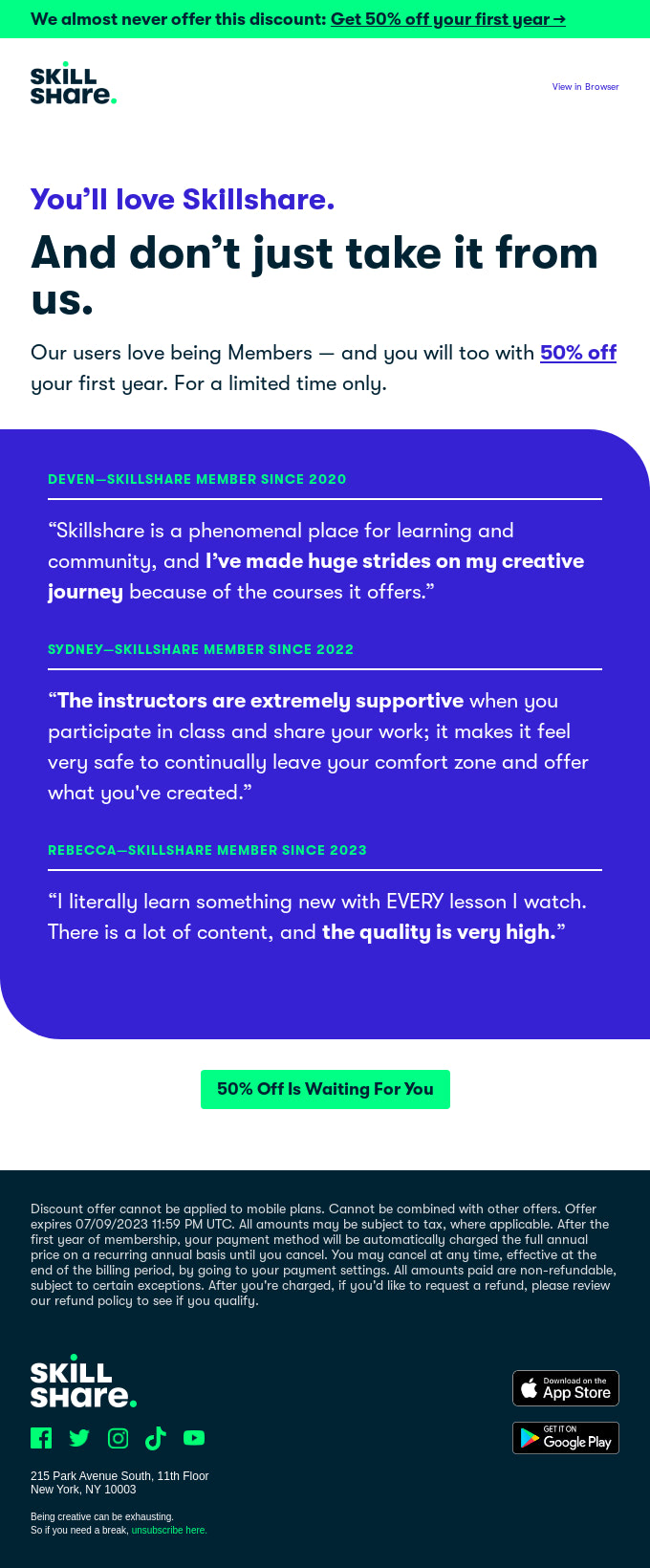
Demonstrate Expertise in the Niche
Providing evidence of your impact, value, and success in your respective niche is a time-proven way to cement your position in the market, gain a competitive advantage, and reinforce your overall brand identity. With a B2B email marketing strategy that demonstrates expertise in the industry, a company becomes known for a specific domain. It establishes itself as a leader and the obvious choice for addressing certain pain points.
Digital newsletters are the best platforms to do that as they are flexible and multifunctional. You may use them to:
- Deliver valuable content that showcases your knowledge, skills, and insights
- Invite other experts and share their thoughts and opinions
- Answer burning questions
- Inspires clients to take part in relevant events
- Showcase results, achievements, awards and accolades
- Share testimonials, reviews, and case studies
Using email design and brand messages, companies may easily prove their credibility, authority, and reputation in their niche.
Examples of Successful B2B Email Marketing Campaigns

We are opening our list of successful B2B email marketing examples with the welcome newsletter from Miro, which gives us great insights on creating an effective introduction and making the first impression count.
Sending out this email after creating an account on the platform, the team does everything they can to make new clients welcome. They bridge the gap with newcomers using the power of words and design. Let’s consider these two aspects closely.
Regarding copy, Miro prefers to get straight to the point and immediately give their subscribers what they need. But first, they do an awesome job setting the tone for the positive relationship they hope to build with their new users through their heart-warming welcome message.
After that, they allocated the entire newsletter to the step-by-step routine of getting started with the platform so their clients could get to the job immediately. They have also included and highlighted links to their informative hub, where clients can find more tutorials to make collaboration with the platform more productive.
As for design, it perfectly reflects the brand’s visual identity. It is clean, neat, and thematic, with the hero section catching an eye and producing a powerful first impression. It is also mobile-friendly, so users may read this email wherever they want.

Unlike Miro, whose team has combined welcome and onboarding emails, Zoom’s email marketers have maximized each type of email. Their onboarding newsletter comes right after the welcome email and builds on the first impression by delivering necessary information for better collaboration.
Again, it includes a small guide with several steps on how to start working with the video platform to meet the needs the company’s departments might have. Every step leads to a corresponding tutorial where readers may get more information on the topic. There is also a link to the learning center.
The email design is based on a stripped layout that effectively breaks information into digestible portions and leads readers from top to bottom, naturally highlighting key details. Note how the team managed to work small illustrations into the layout. Not only do these graphical elements support the copy, but they also improve the reading experience and contribute to the overall professional look.

SetApp provides us with another great example of a B2B onboarding email. Much like Miro, the team has combined it with a welcome email to make the first encounter with the platform productive.
Their newsletter is divided into several sections. The first section greets newcomers with a heartfelt welcome message and a short list of benefits that they might get from this collaboration. The second section guides readers through the basic routine of working with the service. The third section includes vital details about the membership.
Finally, readers find important links to contact the support team and get more information from their information hub.
The email design is relatively neutral compared to the previous two charismatic examples. Nevertheless, it produces a positive professional impression that complements brand identity and image.
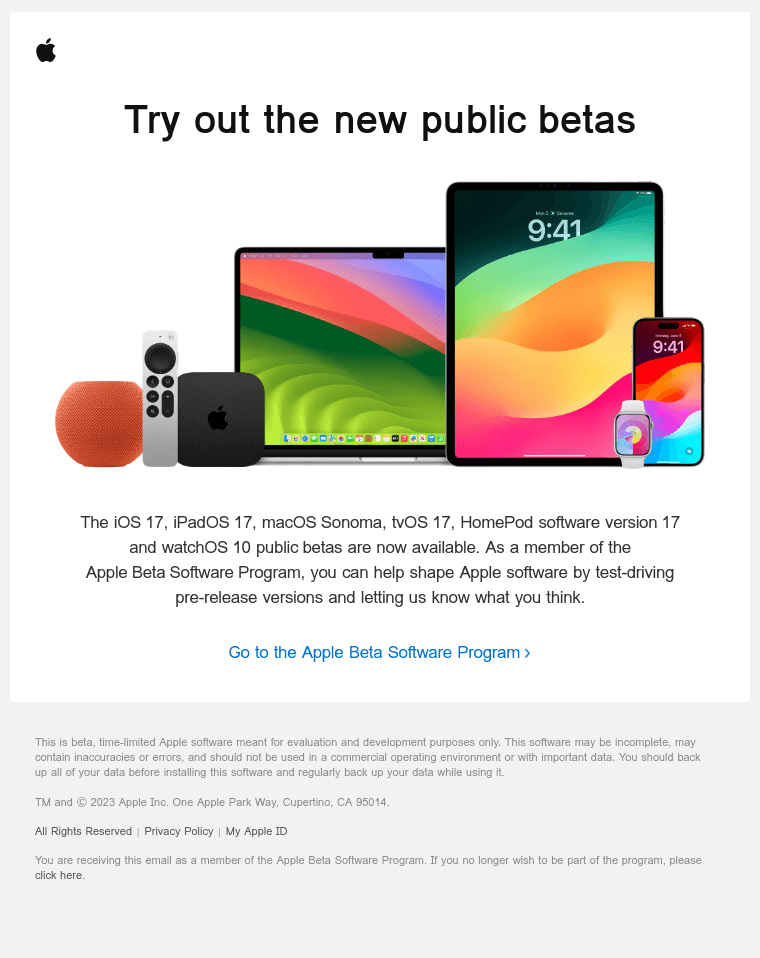
Apple is famous for its love of minimalism and perfection, reflected in its products and B2B email marketing campaigns. Take this email example—it is so compact that it easily fits into a standard laptop screen, featuring just one text block. Nevertheless, this does not diminish its important role in effectively delivering information to loyal customers and cementing their relationships.
This email is an exclusive invitation to test-drive pre-release versions of Apple’s software. It includes only crucial details about the test drive—no clutter or visual overload. The team has skillfully pinpointed the exclusivity of the invitation and made a reader feel an integral part of something big. This is a great way to reinforce professional customer relationships and leave a strong impression.
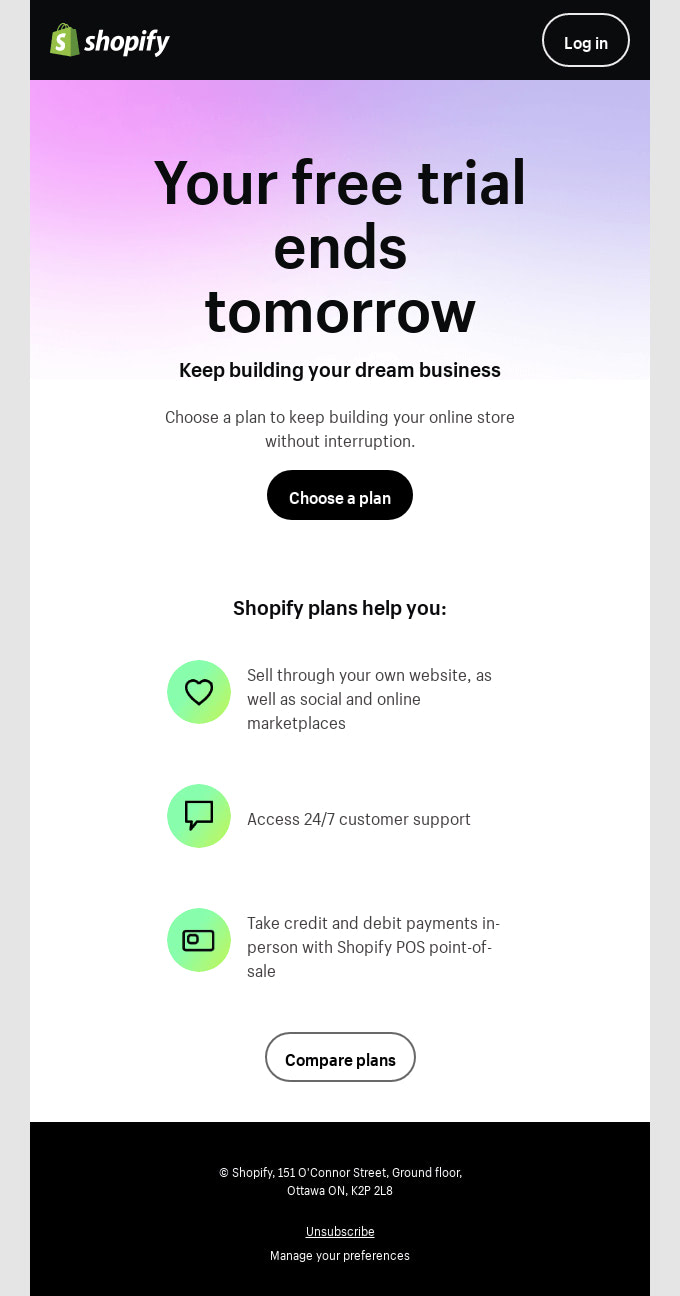
This is another compact B2B email example, provided by leading e-commerce service, Shopify. Their team has created a short and sweet digital newsletter to remind their customers about the upcoming end of the free trial. This way, they initiate a re-engagement campaign without much tension.
The email feels friendly and unobtrusive. The team does not bombard their clients with lots of information or incentives. They give them a glimpse of what they will miss by skipping the deadline. Using a simple structure yet eye-pleasing design, they have made this interaction feel professional, polite, and actionable, thanks to an impossible-to-miss link to pricing plans.

Unlike Apple, the team behind Klaviyo has decided to be slightly more exhaustive about their upcoming event. They have invited their readers and included information about the upcoming training to give hints at what they have in store for their customers. Without spilling the beans, they managed to spark interest, generate engagement, and set certain expectations.
There is more. The newsletter also includes a link to future events and a contact form, which clients may use to ask the expert team questions directly.
Note the email design. It naturally embraces information and serves it pleasantly. Every key detail is stressed out without feeling overwhelming. It nicely plays with the brand’s identity and produces the right impression to cement professional client relationships.
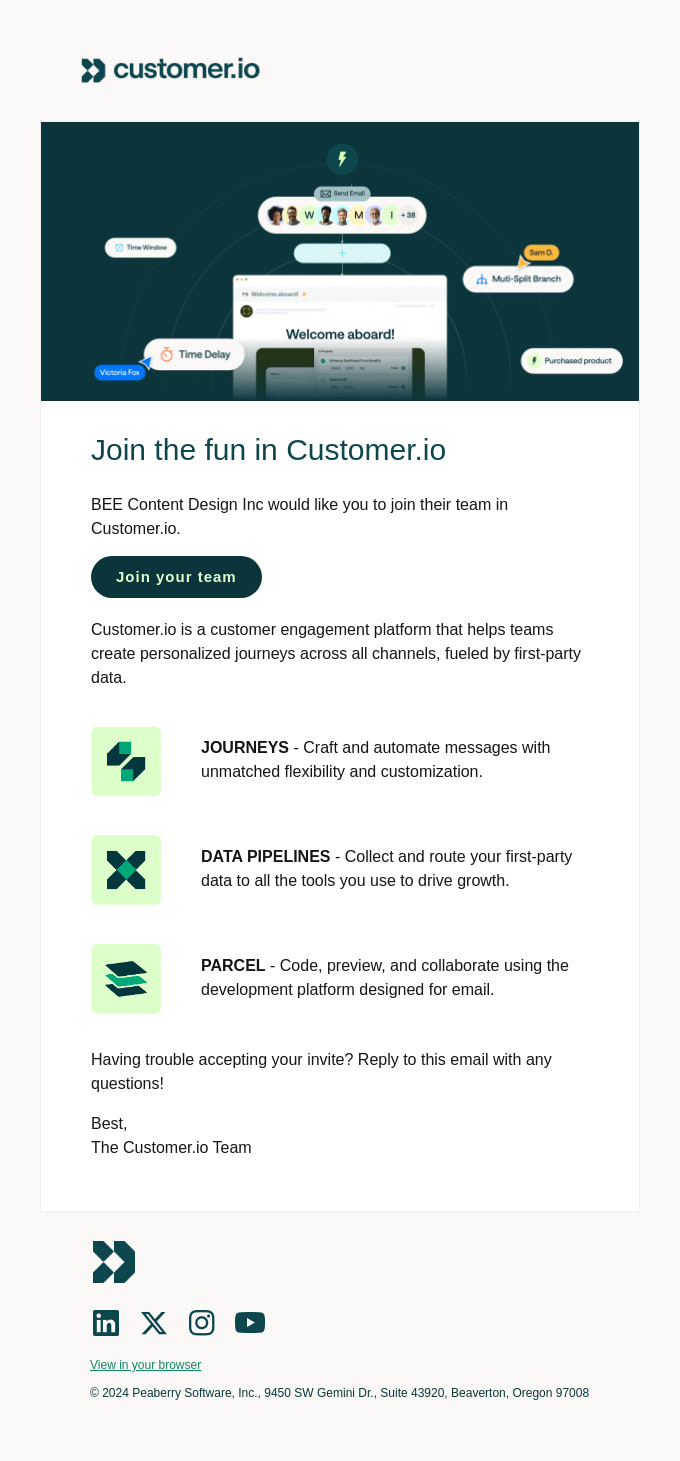
Invitation from Customer.io is a transactional email designed to connect team members who use the platform. It is crucial in creating a productive, friendly, and collaborative environment.
Note how the team uses this opportunity to promote their product to team members and demonstrate company excellence at the professional level. Apart from the invitation strategically placed on top to serve its prime purpose immediately, it also includes key platform benefits to remind representatives of the company of the product’s potential.
The design is simple yet effective. It looks like a compact landing page that perfectly accommodates all the information. The call to action naturally draws attention with its formidable look, whereas well-coordinated illustrations break the reading flow into digestible chunks. The coloring is neutral, yet it goes well with the brand’s visual identity and produces a favorable professional impression.

Customer Support Response from Paypal
Customer support emails are integral to productive and satisfactory communication between companies and clients. They are usually triggered when a customer requests them and serve as a tool to eliminate confusion and boost confidence in the company’s product. Consider PayPal’s newsletter as a good example.
The team has included all the crucial information in their newsletter:
- An immediate link to contact support, represented by a hard-to-miss call-to-action button
- A small yet valuable FAQ section that ends with a link to the help center
- Alternative ways to get in touch, such as initiating a chat with one click
The team has done a great job addressing the main pain point and delivering value right to the door, leaving a strong impression of a company that cares about its business clients.
As for email design, it is worth noting that despite being a technical email, it does not look boring or generic. The team has hit a nice balance between images and text, making it easy to read. They have also taken care of its responsive side and mobile-friendly behavior, ensuring clients enjoy pleasant user experiences across devices.

Survey emails have become increasingly popular among companies across niches as they provide relevant insight crucial for improvement and growth. There are many approaches to conducting them via email (it could be an interactive survey, quiz, or questionnaire). Still, one of the easiest ways is to invite your audience to participate in a survey hosted on your website, as you can get more information there.
This email from Google shows us how to do it without overwhelming clients. The team has sent a compact, almost minimal newsletter centered around an invitation to the survey. They have used copy to clarify what to expect from it and set the right expectations. Design-wise, it’s nothing special (just one illustration), but it demonstrates the usual Google colors that strengthen the connection with the brand, inspire trust, and contribute to brand coherency.

Microsoft’s email is a traditional informative B2B email focused on its main product. It aims to bring customers closer to the product, draw attention to its special proposition, promote its potential, drive customer engagement, and generate conversions without pushy tactics.
Their email looks like an announcement that unobtrusively introduces all the key features that the company is proud of. Using simple and short descriptions accompanied by illustrations, the team tells their clients what each feature offers and how it will benefit them, avoiding cognitive overload. A well-placed call-to-action gives readers a vital getaway to move in the right direction.
As for design, a stripped layout, alternating backdrops, and neutral coloring effectively convey information. A clear headline, clean design, proper formatting, and eye-catching call-to-action underlie a great reading experience.
Conclusion
B2B email marketing refers to informing and promoting products or services to another business through an email channel. While it differs from B2C, which implies interacting with sole decision-makers, it equally yields greater results. It establishes strong relationships with other organizations, amplifies brand identity, cements a company’s position in the market, and generates conversions and revenue.
Marketing to other businesses is very different from marketing to individuals, requiring different strategies and conversion tactics. Companies should understand their sales cycle and accept that it is much longer than in the B2C sector.
It is important to perfect audience segmentation. Apart from analyzing customers’ demands and preferences, they need to divide them into profiles that reflect their position in the company and sales cycle. This includes working closely with initiators, users, buyers, deciders, and gatekeepers.
Businesses should secure the best tools of the trade to benefit from automation and high-end solutions that amplify productivity and allow them to create effective email campaigns.
They should focus on logic and technical specification and use onboarding series and informative and promotional email campaigns to deliver value in every interaction.
Finally, they should adopt the best practices in the niche and track their metrics and progress to introduce timely improvements necessary for growth.
